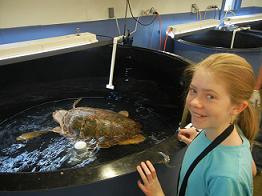Hi, my name is Hailey and I’m N.E.S.T.‘s junior reporter. I’m a volunteer for N.E.S.T. and I just had the coolest experience! On Sunday, January 15th, I went to the North Carolina Aquarium to visit injured sea turtles in the rehabilitation center. There were four sea turtles being treated at the time. They live in round tanks while they’re at the aquarium. The tanks are different in size based on the size of the turtle.

The largest tank held the biggest loggerhead I’ve ever seen! His name was Jason. Jason was cold stunned; that means while he was swimming in the ocean, he got very cold and didn’t know what to do. Since Jason is such a big turtle, he eats a lot of food. I watched the volunteers at the rehabilitation center feed him, and he ate whole fish one after another!
There was another loggerhead named Romano. When Romano gets his tank cleaned, he likes to stick his head under the hose! Romano had pneumonia.  This was partly why Romano was a very slow eater. Pneumonia is when you get water in your lungs and they can get infected. Romano had almost gotten rid of the water in his lungs by the time I came to see him, but he still had a little cough. You could tell by looking at Romano’s shell that he was unhealthy.
This was partly why Romano was a very slow eater. Pneumonia is when you get water in your lungs and they can get infected. Romano had almost gotten rid of the water in his lungs by the time I came to see him, but he still had a little cough. You could tell by looking at Romano’s shell that he was unhealthy.  His scales on his shell were peeling and were pink in color. But don’t worry, the good volunteers at the rehabilitation center are treating Romano so he can be released into his natural home in the Atlantic ocean!
His scales on his shell were peeling and were pink in color. But don’t worry, the good volunteers at the rehabilitation center are treating Romano so he can be released into his natural home in the Atlantic ocean!
There was also a little green sea turtle there. Her name was Autumn. Autumn was also cold stunned, just like Romano. This is kind of a funny fact: green turtles aren’t green! They are actually dark brown with light and dark streaks. Autumn lives in a small tank because she isn’t very big.
Finally, the fourth sea turtle was a little Kemp’s Ridley. His name was Buster. Buster had a tough life before he was rescued and taken to the rehabilitation center. Buster ate something he wasn’t supposed to like a plastic bag or another piece of trash.  It got stuck in his stomach so he felt full all the time and he didn’t eat anything. When he got rescued, no matter how hard the volunteers tried to feed him, he wouldn’t eat. He was given a laxative which made him go to the bathroom. The bad piece of plastic finally came out and he started eating again. He still had to be monitored because his digestive system still didn’t work correctly.
It got stuck in his stomach so he felt full all the time and he didn’t eat anything. When he got rescued, no matter how hard the volunteers tried to feed him, he wouldn’t eat. He was given a laxative which made him go to the bathroom. The bad piece of plastic finally came out and he started eating again. He still had to be monitored because his digestive system still didn’t work correctly.
As you can see, the NC Aquarium’s rehabilitation center for turtles is a busy place. As the current turtles get better, they are released, but there are always new ones coming in! Do your part to help keep Sea turtles safe! Pick up trash on the beach, don’t litter, and know the N.E.S.T. Hotline number in case you find a stranded sea turtle. That number is (252)-441-8622
*We don’t actually know if a turtle is a boy or a girl until they grow up.*
(Note: Jason, Buster, and Romano were released back into the ocean in early February. Wish them luck! To learn more about the turtles in the Rehabilitation Center and their progress toward recovery, subscribe to the blog on the N.E.S.T. website.)
